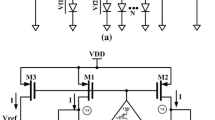Abstract
In this study, a low-dropout voltage regulator (LDO) system composed of two LDOs, which can operate in the temperature range of 77–400 K, has been developed. Cryogenic and typical transistor models of the 180 nm UMC CMOS process have been employed in the design process. Both LDOs can provide a load current of 100 mA while generating four different output voltage levels (0.9 V, 1.2 V, 1.5 V, 1.8 V). The LDO system provides 70 mV, 60 mV, 60 mV, and 50 mV dropout voltages at 77 K, and 111 mV, 108 mV, 110 mV, and 82 mV dropout voltages at 400 K, for the output voltage levels 0.9 V, 1.2 V, 1.5 V, and 1.8 V, respectively. Post-layout simulation results of the overall LDO system present that the output voltage varies by 30 mV over the broad range of temperatures from 77 K to 400 K.










Similar content being viewed by others
References
Radebaugh, R. (2002). Cryogenic technology resources. https://trc.nist.gov/cryogenics/aboutCryogenics.html Accessed 26 Mar 2020.
Cressler, J. D. (2013). Radiation effects in SiGe technology. IEEE Transactions on Nuclear Science, 60(3), 1992.
Hou, W., Li, S., Geronimo, G. D., & Stanaćević, M. (2018). In 2018 IEEE nuclear science symposium and medical imaging conference proceedings (NSS/MIC) (pp. 1–4).
Homulle, H., & Charbon, E. (2018). Cryogenic low-dropout voltage regulators for stable low-temperature electronics. Cryogenics, 95, 11. https://doi.org/10.1016/j.cryogenics.2018.08.006.
Leng, H., Fu, G., Jiang, M., Wan, B., Zhang, Z. (2018). In 2018 12th international conference on reliability, maintainability, and safety (ICRMS) (pp. 262–265). https://doi.org/10.1109/ICRMS.2018.00056.
Streetman, B. G., & Banerjee, S. K. (2016). Solid state electronic devices (7th ed.). London: Pearson Education Limited.
Incandela, R. M., Song, L., Homulle, H. A. R., Sebastiano, F., Charbon, E., & Vladimirescu, A. (2017). In 2017 47th European solid-state device research conference (ESSDERC) (pp. 58–61). https://doi.org/10.1109/ESSDERC.2017.8066591.
Beckers, A., Jazaeri, F., Bohuslavskyi, H., Hutin, L., Franceschi, S. D., & Enz, C. (2019). Characterization and modeling of 28-nm FDSOI CMOS technology down to cryogenic temperatures. Solid-State Electronics, 159, 106. https://doi.org/10.1016/j.sse.2019.03.033.
Luo, C., Li, Z., Lu, T. T., Xu, J., & Guo, G. P. (2019). MOSFET characterization and modeling at cryogenic temperatures. Cryogenics, 98, 12. https://doi.org/10.1016/j.cryogenics.2018.12.009.
Varizat, L., Sou, G., Mansour, M., Alison, D., & Rhouni, A. (2017). In 2017 IEEE international workshop on metrology for aerospace (MetroAeroSpace) (pp. 74–78). https://doi.org/10.1109/MetroAeroSpace.2017.7999541.
Varizat, L., Sou, G., Mansour, M., & Alison, D. (2018). A cryogenic 0.35 μm CMOS technology BSIM33 model for space instrumentation: Application to a bandgap design. IEEE Aerospace and Electronic Systems Magazine, 33(8), 24. https://doi.org/10.1109/MAES.2018.170149.
Kabaoğlu, A., & Yelten, M. B. (2017). In 2017 14th international conference on synthesis, modeling, analysis and simulation methods and applications to circuit design (SMACD) (pp. 1–4). https://doi.org/10.1109/SMACD.2017.7981578
Kabaoğlu, A., Şahin-Solmaz, N., İlik, S., Uzun, Y., & Yelten, M. B. (2019). Statistical MOSFET modeling methodology for cryogenic conditions. IEEE Transactions on Electron Devices, 66(1), 66. https://doi.org/10.1109/TED.2018.2877942.
Kabaoğlu, A., Şahin-Solmaz, N., İlik, S., Uzun, Y., & Yelten, M. B. (2019). Variability-aware cryogenic models of mosfets: Validation and circuit design. Semiconductor Science and Technology, 34(11), 115004. https://doi.org/10.1088/1361-6641/ab3ff9.
Choi, J., Park, J., Jeong, W., Lee, J., Lee, S., Yoon, J., et al. (2009). In 2009 international SoC design conference (ISOCC) (pp. 420–423). https://doi.org/10.1109/SOCDC.2009.5423864.
Souri, K., Chae, Y., Ponomarev, Y., & Makinwa, K. A. A. (2011). In 2011 proceedings of the ESSCIRC (ESSCIRC) (pp. 279–282). https://doi.org/10.1109/ESSCIRC.2011.6044961.
Tuthill, M. (1997). In Proceedings of the 23rd European solid-state circuits conference (pp. 228–231).
Razavi, B. (2001). Design of analog CMOS integrated circuits (1st ed.). New York: McGraw-Hill.
Hilbiber, D. (1964). In 1964 IEEE international solid-state circuits conference. Digest of technical papers (Vol. VII, pp. 32–33). https://doi.org/10.1109/ISSCC.1964.1157541
Malcovati, P., Maloberti, F., Fiocchi, C., & Pruzzi, M. (2001). Curvature-compensated BiCMOS bandgap with 1-V supply voltage. IEEE Journal of Solid-State Circuits, 36(7), 1076. https://doi.org/10.1109/4.933463.
Sun, N., & Sobot, R. (2010). In CCECE 2010 (pp. 1–5). https://doi.org/10.1109/CCECE.2010.5575247.
Cressler, J. D., Crabbe, E. F., Comfort, J. H., Stork, J. M. C., & Sun, J. Y. (1993). On the profile design and optimization of epitaxial Si- and SiGe-base bipolar technology for 77 K applications. II. Circuit performance issues. IEEE Transactions on Electron Devices, 40(3), 542. https://doi.org/10.1109/16.199359.
Annema, A. (1999). Low-power bandgap references featuring DTMOSTs. IEEE Journal of Solid-State Circuits, 34(7), 949. https://doi.org/10.1109/4.772409.
Homulle, H., Sebastiano, F., & Charbon, E. (2018). Deep-cryogenic voltage references in 40-nm CMOS. IEEE Solid-State Circuits Letters, 1(5), 110. https://doi.org/10.1109/LSSC.2018.2875821.
Kayıhan, H. I., Kabaoğlu, A., & Yelten, M. B. (2019). In 2019 11th international conference on electrical and electronics engineering (ELECO) (pp. 392–396). https://doi.org/10.23919/ELECO47770.2019.8990394.
Marasco, K. (2009). How to successfully apply low-dropout regulators. Analog Dialogue, 43, 1–4.
Patoux, J. (2007). Ask the applications engineer, low-dropout regulators. Analog Dialogue, 41, 1–3.
Sinencio, E. S. (2010). Low drop-out (LDO) linear regulators: Design considerations and trends for high power-supply rejection (PSR). IEEE Santa Clara Valley (SCV) Solid State Circuits Society.
Lee, B. S. (1999). Understanding the terms and definitions of LDO voltage regulators. Texas Instruments, Application Report.
Acknowledgements
This work was sponsored by the Technological Research Council of Turkey under the Project TÜBİTAK 1001 215E080.
Author information
Authors and Affiliations
Corresponding author
Additional information
Publisher's Note
Springer Nature remains neutral with regard to jurisdictional claims in published maps and institutional affiliations.
Rights and permissions
About this article
Cite this article
Kayıhan, H.İ., İnam, B.B., Doğan, B. et al. A wide-temperature range (77–400 K) CMOS low-dropout voltage regulator system. Analog Integr Circ Sig Process 106, 501–510 (2021). https://doi.org/10.1007/s10470-020-01715-9
Received:
Revised:
Accepted:
Published:
Issue Date:
DOI: https://doi.org/10.1007/s10470-020-01715-9




